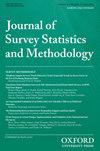Peekaboo! The Effect of Different Visible Cash Display and Amount Options During Mail Contact When Recruiting to a Probability-Based Panel
IF 1.6
4区 数学
Q2 SOCIAL SCIENCES, MATHEMATICAL METHODS
引用次数: 0
Abstract
Abstract Recent studies consistently showed that making cash visible with a windowed envelope during mail contact increases response rates in surveys. The visible cash aims to pique interest and encourage sampled households to open the envelope. This article extends prior research by examining the effect of additional interventions implemented during mail recruitment to a survey panel on recruitment rates and costs. Specifically, we implemented randomized experiments to examine size (small, large) and location (none, front, back) of the window displaying cash, combined with what part of the cash is shown through the window envelope (numeric amount, face/image), and various prepaid incentive amounts (two $1, one $2, one $5). We used the recruitment effort for NORC’s AmeriSpeak Panel as the data source for this study. The probability-based AmeriSpeak Panel uses an address-based sample and multiple modes of respondent contact, including mail, phone, and in-person outreach during recruitment. Our results were consistent with prior research and showed significant improvement in recruitment rates when cash was displayed through a window during mail contact. We also found that placing the window on the front of the envelope, showing $5 through the envelope compared to $2 and $1, and showing the tender amount compared to the image on the cash through the window were more likely to improve the recruitment rates. Our cost analyses illustrated that the cost difference in printing window versus no window envelope is small. There is no difference in printing cost between front window and back window as they both require custom manufacturing. There is also no cost difference in printing envelopes with small windows versus large windows. Lastly, we found no evidence of mail theft based on our review of the United States Postal Service’s “track and trace” reports, seed mailings sent to staff, and undeliverable mailing rates.躲躲猫!招聘到一个基于概率的小组时,不同的可见现金显示和金额选项在邮件联系期间的影响
最近的研究一致表明,在邮件联系过程中,用带窗口的信封显示现金可以增加调查的回复率。这些看得见的现金旨在激起人们的兴趣,并鼓励被抽样的家庭打开信封。本文通过检查邮件招聘期间实施的额外干预措施对招聘率和成本的影响,扩展了先前的研究。具体来说,我们实施了随机实验来检查展示现金的窗口的大小(小、大)和位置(没有、前面、后面),并结合窗口信封显示的现金部分(数字金额、人脸/图像)和各种预付奖励金额(两个1美元、一个2美元、一个5美元)。我们使用NORC的AmeriSpeak Panel的招聘工作作为本研究的数据源。基于概率的AmeriSpeak Panel使用基于地址的样本和多种受访者联系模式,包括邮件,电话和招聘期间的亲自外展。我们的结果与之前的研究一致,表明在邮件联系时通过窗口显示现金,招聘率有了显著提高。我们还发现,在信封正面放置窗口,通过信封显示5美元,而不是2美元和1美元,通过窗口显示招标金额,而不是现金上的图像,更有可能提高招聘率。我们的成本分析表明,印刷窗口与无窗口信封的成本差异很小。前窗和后窗的打印成本没有区别,因为它们都需要定制制造。打印小窗口和大窗口的信封也没有成本差异。最后,根据我们对美国邮政服务的“跟踪和追踪”报告、发送给员工的种子邮件和无法投递的邮件率的审查,我们没有发现邮件被盗的证据。
本文章由计算机程序翻译,如有差异,请以英文原文为准。
求助全文
约1分钟内获得全文
求助全文
来源期刊
CiteScore
4.30
自引率
9.50%
发文量
40
期刊介绍:
The Journal of Survey Statistics and Methodology, sponsored by AAPOR and the American Statistical Association, began publishing in 2013. Its objective is to publish cutting edge scholarly articles on statistical and methodological issues for sample surveys, censuses, administrative record systems, and other related data. It aims to be the flagship journal for research on survey statistics and methodology. Topics of interest include survey sample design, statistical inference, nonresponse, measurement error, the effects of modes of data collection, paradata and responsive survey design, combining data from multiple sources, record linkage, disclosure limitation, and other issues in survey statistics and methodology. The journal publishes both theoretical and applied papers, provided the theory is motivated by an important applied problem and the applied papers report on research that contributes generalizable knowledge to the field. Review papers are also welcomed. Papers on a broad range of surveys are encouraged, including (but not limited to) surveys concerning business, economics, marketing research, social science, environment, epidemiology, biostatistics and official statistics. The journal has three sections. The Survey Statistics section presents papers on innovative sampling procedures, imputation, weighting, measures of uncertainty, small area inference, new methods of analysis, and other statistical issues related to surveys. The Survey Methodology section presents papers that focus on methodological research, including methodological experiments, methods of data collection and use of paradata. The Applications section contains papers involving innovative applications of methods and providing practical contributions and guidance, and/or significant new findings.

 求助内容:
求助内容: 应助结果提醒方式:
应助结果提醒方式:


